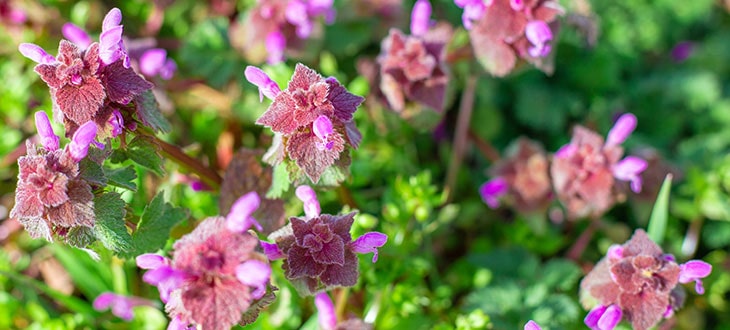9 Weeds With Purple Stem
Found some weeds with purple stems and want to identify them? Here are several species of weeds whose stems are entirely or partly purple.
Plants are easier or harder to identify depending on their particularities. Some have leaves that stand out, others can be recognized by their flowers, fruits, seeds, or other elements.
Today we will talk about several species of weeds that can be recognized by their purple stems.
Contents
- 1. Pokeweed (Phytolacca Americana)
- 2. Amaranth
- 3. Purple Deadnettle (Lamium Purpureum)
- 4. The Castor Bean (Ricinus Communis)
- 5. Jimsonweed (Datura stramonium)
- 6. Purplestem Angelica (Angelica Atropurpurea)
- 7. Crofton weed (Ageratina Adenophora)
- 8. Common Ragwort (Jacobaea Vulgaris)
- 9. Ground ivy (Glechoma Hederacea)
1. Pokeweed (Phytolacca Americana)

Pokeweed (Phytolacca Americana) is a perennial plant in the family Phytolaccaceae. It is also known as American pokeweed, poke sallet, dragonberries, or inkberry.
This plant is native to parts of North America and naturalized in many regions of Europe and Asia. It is generally considered a pest weed as all of its parts are poisonous to humans and to most species of animals.
Pokeweed grows up to 10 feet (3 m) in height. Its leaves are large, bright green, and have an elliptical shape.
The stems are reddish-purple and develop from a large white taproot.
Pokeweed produces green to white flowers which bear green berries that become purple to almost black when ripen.
2. Amaranth

Amaranthus is a genus of over 70 short-lived perennials and annuals, collectively known as “amaranths.” They can be found throughout the world, except in Antarctica.
Many of the species in this genus are regarded as summer annual weeds, and are generally called “pigweeds.” There are also some varieties that are used as ornamental plants, cultivated as pseudocereals, or as leaf vegetables.
Not all species of Amaranth have purple stems and this is not an unmistakable feature that enables you to correctly identify plants of this genus. However, this characteristic, along with the shape of the leaves, the presence of seeds, and other details, can help you easily recognize these plants.
Amaranth plants grow upright and their size varies from one species to another. Although most species do not exceed 3 feet (1 m) in height, there are some that can grow up to 8 feet (2.5 m).
The color of their flowers, stems, and leaves may vary from green to reddish, purplish, or crimson. The stems are fibrous, cylindrical, and hollow.
3. Purple Deadnettle (Lamium Purpureum)
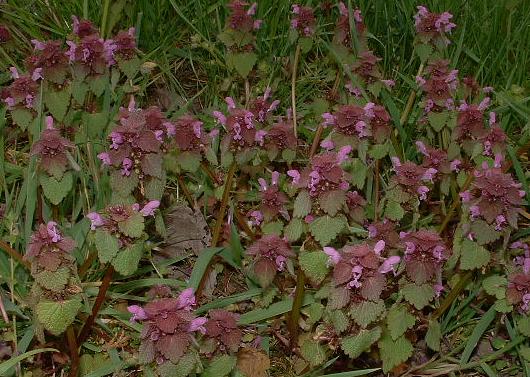
Purple Deadnettle (Lamium purpureum) is an annual weed native to Europe and Asia. Other common names of this plant include red dead-nettle or purple archangel.
This plant doesn’t grow tall and forms dense patches.
Its stems have a square shape and get a reddish-purple color starting from the base of the plant toward the top as the plant ages.
The leaves are green at the bottom of the plant and shade to purplish at the top, are covered with delicate hairs, have wavy to serrated margins, and attach to the stem via petioles.
Purple deadnettle blooms throughout the year and produces bright red-purple flowers with a hood-like look.
4. The Castor Bean (Ricinus Communis)

The castor bean (Ricinus communis), Ricinus, or castor oil plant, is a fast-growing perennial plant native to the southeastern Mediterranean Basin, India, and Eastern Africa. It is largely grown as an ornamental plant in many parts of the world.
A Ricinus plant grows as a shrub and can reach the size of a small tree.
It has a robust, tall main stalk that branches towards the top of the plant. The stems have a crimson to sometimes purple color in some varieties or dark green in others.
The leaves are broad, palmate, glossy, and are either green or reddish-purple in color depending on the age of the plant and variety.
The flowers do not have petals and develop in terminal clusters of green or reddish inflorescences.
The fruits are greenish or reddish-purple spiny capsules that contain bean-like seeds. The seeds are highly toxic as they contain a powerful toxin called ricin.
5. Jimsonweed (Datura stramonium)
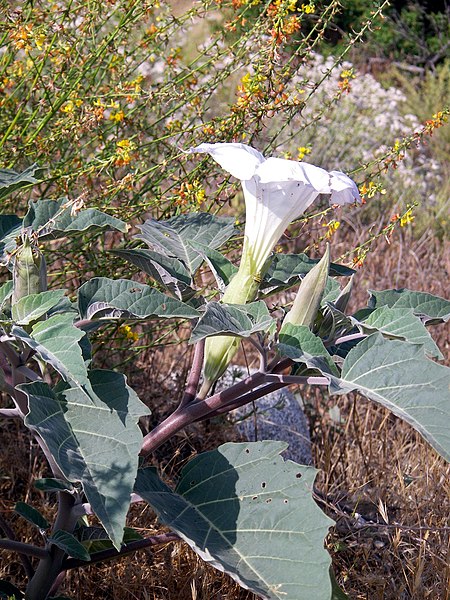
Jimsonweed (Datura stramonium) is an annual plant that can be found throughout the world. It is also commonly known as thorn apple, devil’s snare, or devil’s trumpet.
It is considered an invasive weed in temperate climates as it competes aggressively with cultivated plants. Also, all its parts are poisonous.
Datura stramonium grows upright, the stalk is stout, branched, smooth, and has a yellow-green to reddish-purple color.
Its leaves are wide, toothed, irregularly undulated and their upper surface is of a darker green than the underside.
During summertime, this plant produces white to creamy or violet trumpet-shaped flowers.
6. Purplestem Angelica (Angelica Atropurpurea)

Purplestem angelica (Angelica atropurpurea) is a perennial plant native to North America. It is also known as great angelica, masterwort, American angelica, or high angelica.
Angelica atropurpurea is a moist-loving plant. It is frequently found growing on riverbanks, or in swampy woodlands.
The plant grows upright and can exceed 8 feet (2.5 m) in height in the right conditions.
It has a vertical, vigorous, main stalk that branches toward the top of the plant. It is hollow inside, has a smooth surface and a purple color.
The leaves are green, large, and compound, with 3-5 leaflets on a branch and toothed margins.
Purplestem angelica produces white to greenish flowers, arranged in umbrella-like clusters (umbels).
7. Crofton weed (Ageratina Adenophora)
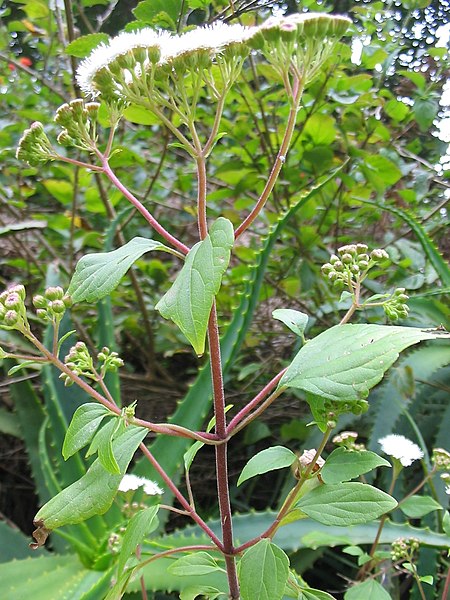
Crofton weed (Ageratina adenophora) is a perennial shrub native to Mexico and Central America. It is also commonly known as Mexican devil, thoroughwort, eupatory, sticky eupatorium, or sticky snakeroot.
It was introduced to many countries as an ornamental plant but has later become an invasive species.
Crofton weed grows as a small shrub and typically does not exceed 5 feet (1.5 m) in height.
The stems are erect, have a purple color, and are covered with hairs.
The leaves are green, grow oppositely on the stems, have a deltate-ovate shape, and have serrated margins.
In late spring and summer, crofton weed produces clusters of tiny, white compound flowers at the end of branches.
8. Common Ragwort (Jacobaea Vulgaris)
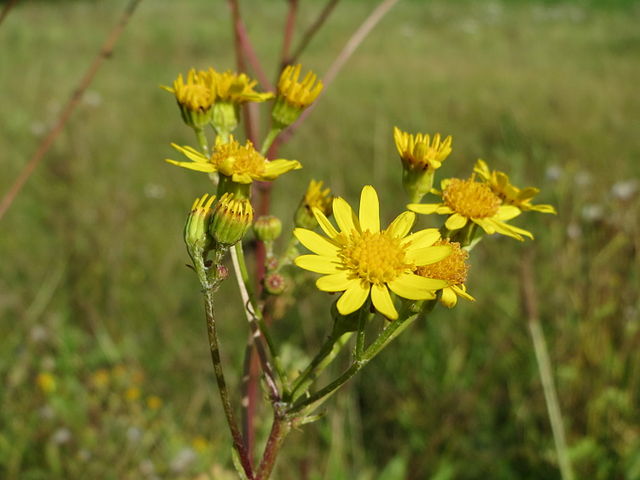
Common Ragwort (Jacobaea Vulgaris) is a biennial to short-lived perennial plant native to Europe and Asia. It has many names, including ragwort, tansy ragwort, stinking willie, or benweed.
While in some countries is considered a wildflower, in others, it is regarded as a noxious weed.
The plant doesn’t typically exceed 3.2 feet (1 m) in height. Its stems are erect, branched, light green, and occasionally with purple tints.
The leaves are green, pinnately lobed, dentate, and grow alternately on the stem.
In the blooming period, Jacobaea vulgaris produces bright yellow dense clusters of flower heads.
9. Ground ivy (Glechoma Hederacea)
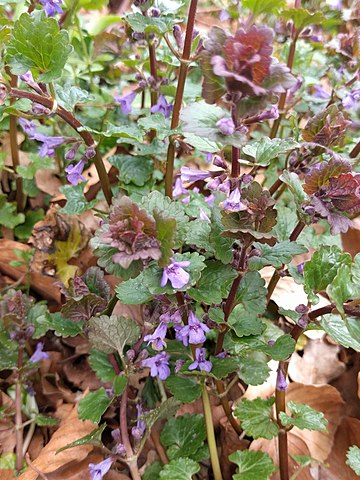
Ground ivy (Glechoma hederacea) is a perennial weed in the mint family. Other common names for this plant include creeping charlie, gill-over-the-ground, catsfoot, alehoof, and tunhoof.
This plant frequently grows in grasslands and wooded areas, but also in lawns, where can create dense tufts of plants.
It doesn’t grow tall, typically not exceeding 16 inches (40 cm) in height. It has square stems that are frequently a mixture of green, red and purple.
The leaves are kidney-shaped, have a hairy upper surface, round toothed edges, and grow opposedly on the stems.
During spring, Glechoma hederacea produces funnel-shaped blue or bluish-violet flowers that grow in opposed clusters in the leaf axils on the superior part of the stem or close to the tip.
Final Word
Although many plants have a purple stem or at least acquire a shade of purple in one of their development stages, we have made a list of some species of weeds that have this peculiarity.
We hope this will help you identify easier the weeds you find in your garden, in the woods, or on your wildlife expeditions that pose this feature.
You may also want to take a look at our list of plants with red stems.

